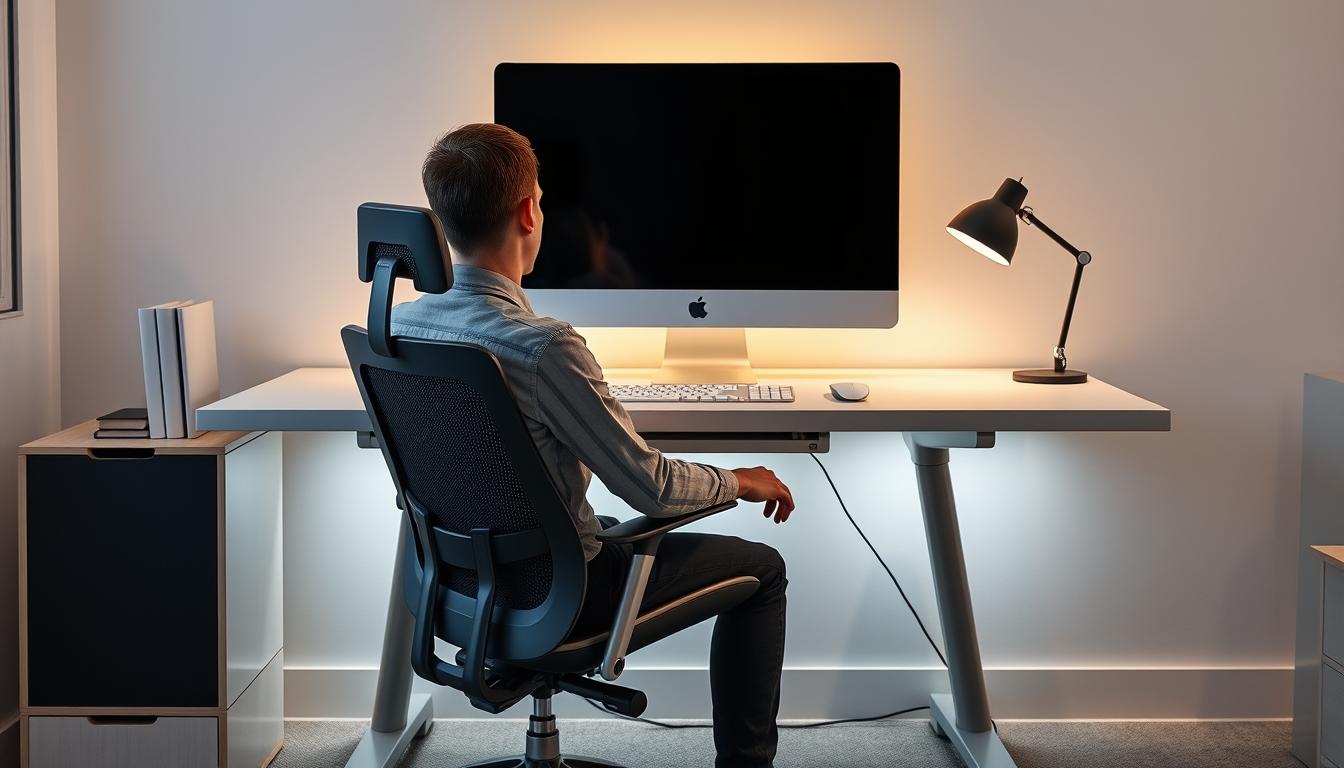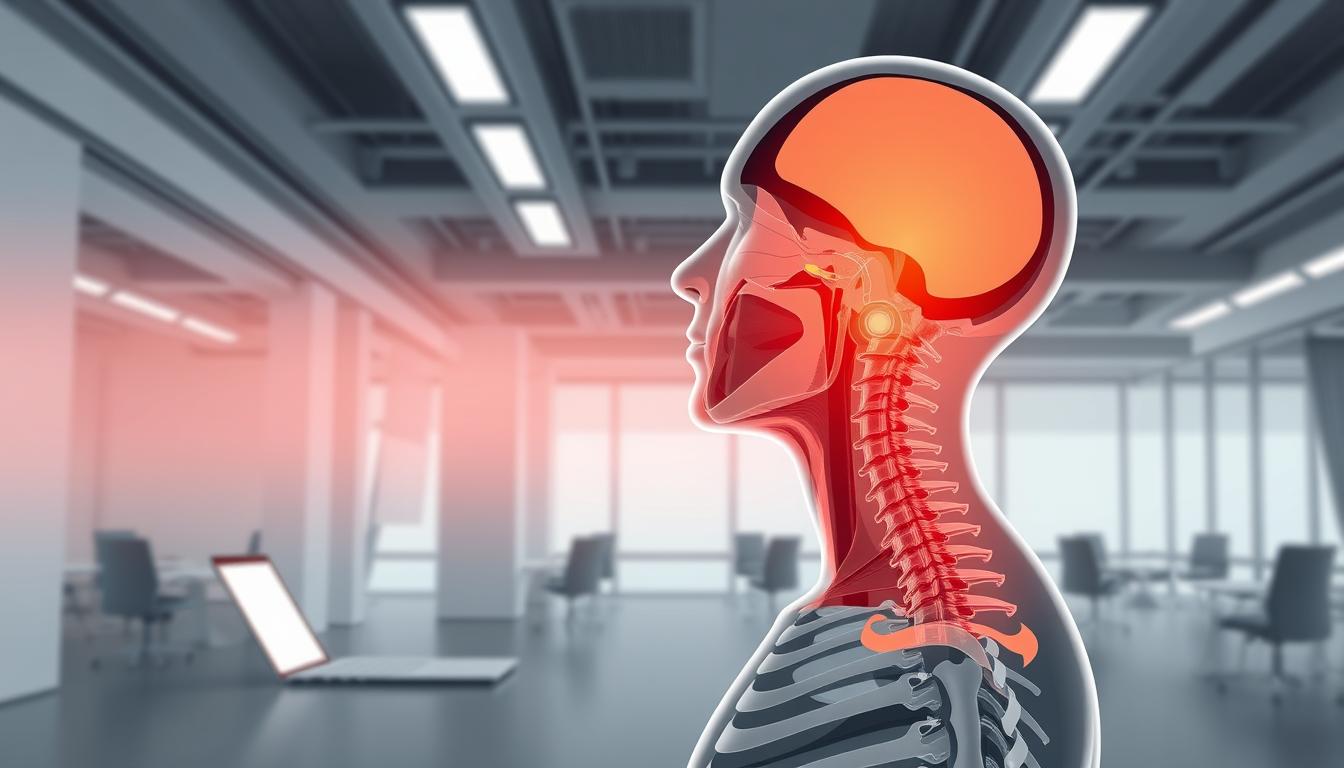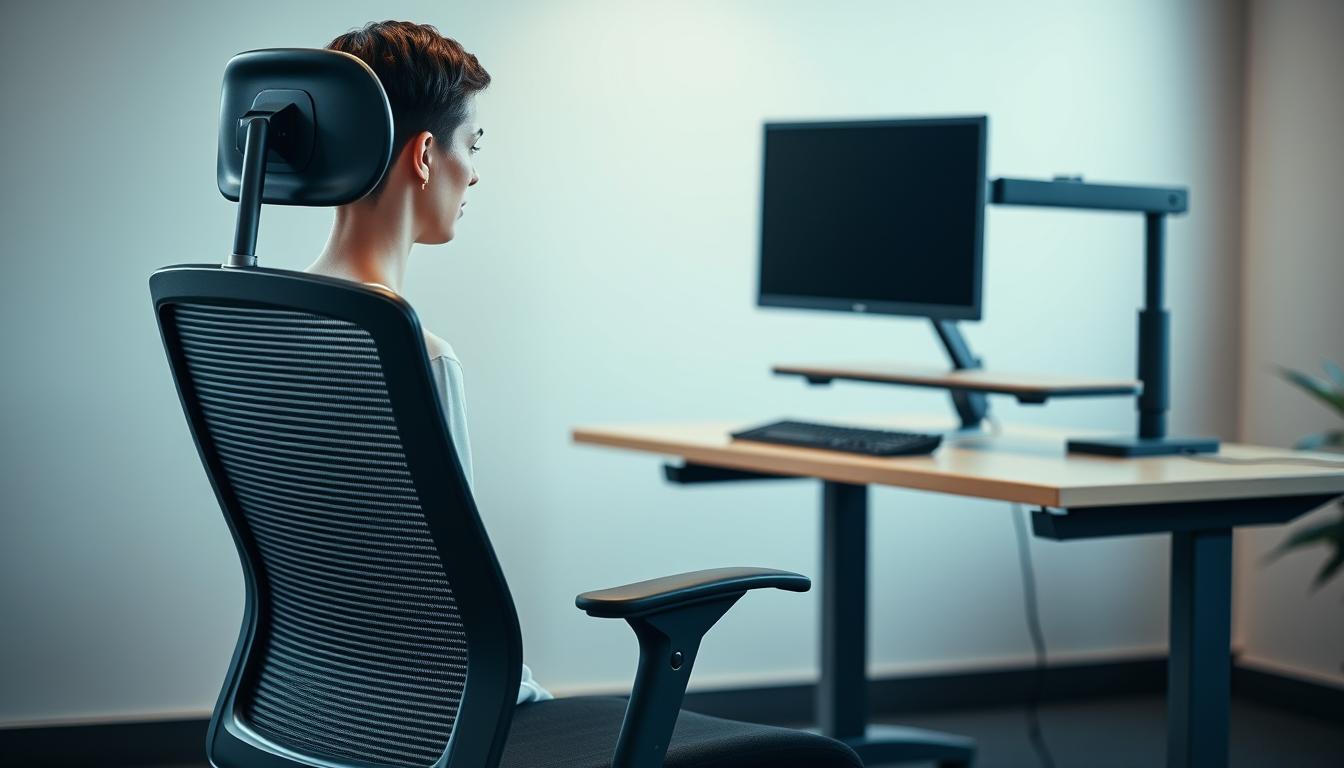More people are working from home now, making it important to set up a comfortable workspace. Ergonomics, or the study of efficiency in work environments, can really affect your comfort and productivity. By creating a good setup, you can avoid problems like neck strain, back pain, and wrist discomfort. In this article, we talk about easy ergonomic tips. These can improve both your health and work performance.
Understanding Ergonomics in Laptop Use
Ergonomics helps make laptop use healthy. It’s about setting up your space to meet your needs. This is key to keeping your muscles and bones healthy. Many studies show that bad ergonomics with laptops can hurt your posture. This can cause discomfort and long-term health problems.
To better your laptop ergonomics, you need to grasp the basics. It’s all about how you arrange your seat and gear. You want your laptop screen at eye level and a supportive chair. This helps reduce neck and back strain.
Making your workspace suit your personal dimensions is important. It leads to a more comfortable work area. Focusing on these ideas can make your workspace better. This boosts work performance and happiness. Deciding to follow good laptop ergonomics is a key move for your health.
The Importance of Proper Sitting Posture
When using a laptop, it’s key to sit the right way to keep your spine healthy. The right posture keeps your back’s natural curve and makes your shoulders relaxed. It also keeps muscles and ligaments from getting too strained. Sitting up straight stops you from feeling uncomfortable or tired.
Studies show that having your feet flat and knees bent at 90 degrees is good for your posture. This keeps your spine neutral which is important for your back’s health in the long run. Moving around a bit now and then helps get rid of stiffness and boosts blood flow.
Being aware of how you sit with a laptop is more than just for comfort. It’s very important for stopping muscle and bone issues before they start.
Ergonomic Tips for Laptop Users
It’s key to create a cozy and productive laptop workspace. Choosing the right seating and desk setup is vital. These steps help keep good posture and lower strain. By doing so, working becomes more enjoyable.
Choosing the Right Chair
Finding the perfect ergonomic chair is key for long-term comfort. An adjustable chair fits your body perfectly. It should support a healthy spine and offer comfort. Look for lumbar support and height adjustability for the best posture.
Optimizing Desk Height
The height of your desk impacts your ergonomic space. Your desk should let your elbows rest at 90 degrees while typing. This prevents discomfort and injury. If your desk doesn’t adjust, try using sturdy materials to raise it or a footrest for the right angle.
Creating an Effective Laptop Setup
Making your laptop setup better can really boost how well you work and your productivity. Adding things like keyboards and mice makes your laptop higher, which is easier on your wrists. Getting your screen in the right spot is also key to keeping a good posture and not hurting your neck.
Using External Keyboards and Mice
Adding external keyboards and mice can change how your workspace feels. If you put your laptop on a stand or some books, it brings the screen up to your eyes. This helps you sit straight and lowers the chance of hurting your hands from typing too much. These extra devices let you adjust your setup for better comfort and help keep your workspace good for your body.
Positioning Your Laptop Screen
Where your screen is set up matters a lot when you’re using it a lot. You want the top of the screen to be level with your eyes. This stops you from having to bend your neck, which can cause pain or more serious problems later. The best distance between your eyes and the screen is about 20 to 30 inches. Setting up your screen the right way helps you work better and stay comfy.
Minimizing Neck and Shoulder Strain
Laptop users often have neck and shoulder pain. It’s mostly because they don’t set up their laptops correctly. Putting your laptop at eye level stops you from bending your neck too much. This simple move can make a big difference in easing your pain.
Also, tilting your screen so it’s just right helps reduce strain. When your laptop is in a good position, you can sit more comfortably. This means less pain in your neck and shoulders. Plus, taking breaks to stretch keeps your muscles relaxed.
Making your workspace better is key too. Have a chair that supports you and a desk at the right height. These changes make your space better for your body. You’ll enjoy using your laptop more and get more done.
Maintaining Proper Wrist Alignment
Keeping your wrist in the right position is key for long-time laptop users. It stops repetitive strain injuries and keeps you comfortable. To do this right, you have to watch your wrist and body position closely.
Utilizing a Footrest
For those whose chairs are too tall, a footrest is a big help. It lets users keep their feet flat, making their legs more comfortable. This also helps keep wrists in the right position.
Keyboard and Mouse Placement
The right spot for your keyboard is vital to keep wrists happy. The keyboard and mouse should sit at the same height to avoid stretching. This helps keep your wrists in a good spot, easing strain on your arms and wrists.

The Role of Frequent Breaks
Frequent breaks are very important for keeping healthy and being more productive at work. When you’re using your laptop for a long time, taking breaks is key. It greatly reduces the chance of your eyes getting tired, a common problem for laptop users.
One great way to rest your eyes is the 20/20/20 rule.
Understanding the 20/20/20 Rule
The 20/20/20 rule is easy to follow and helps a lot. Every 20 minutes, take a moment to look at something 20 feet away for 20 seconds. This habit helps prevent your eyes from feeling tired after staring at a screen for too long.
Adding a little stretch or standing up during these breaks is also good. It helps your blood flow better and relaxes your muscles. Using these breaks and the 20/20/20 rule will make you feel better. Plus, you’ll do better at your work tasks.
Making Home Workspaces Ergonomically Friendly
With more people working from home, it’s key to improve comfort in workspaces. A snug home office can boost productivity and health. Adjustable furniture helps tailor your space to fit your needs perfectly.
If you don’t have special furniture, you’re not out of luck. Use cushions or boxes to lift your screen for a better view. This small change can ease neck and back discomfort.
Keeping your space tidy helps you concentrate better. Here are tips for a better home office:
- Incorporate adjustable furniture for a versatile setup.
- Ensure that screens are at eye level to promote better posture.
- Utilize supportive seating that aligns with your body’s natural shape.
- Keep frequently used items within easy reach to minimize stretching.
Setting up your home workspace with care can make it more pleasant and productive. This leads to better performance over time.
Conclusion
In summary, using the right setup for your laptop is key to feeling comfortable and working better. By following the advice we talked about, you can reduce pain and make work more fun. Remember, ergonomics is more than just making things look good. It’s about setting up a healthy place to work that looks after your well-being.
Everyone’s needs for their workspace are different. This means you need to customize solutions to meet your needs. It’s important to check and tweak your setup regularly to get the best fit. Taking steps towards a healthier workspace is all about knowing what’s best, making smart choices, and being dedicated to getting better.
To keep comfortable and efficient with a laptop, add ergonomic tips into your daily habits. By doing this, you’re not only improving your workday but also your health in the long run.



